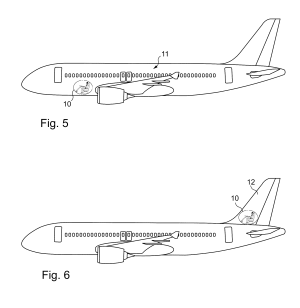
The FAA thinks FPV should be illegal while the airline industry is filing patents on flying airliners with no windows.
An article published in the Seattle Post-Intelligencer the other evening describes a patent application from European aerospace company Airbus in which pilots fly aircraft entirely through electronic means. The patent application, number US20140180508 A1, is titled "Aircraft with a cockpit including a viewing surface for piloting which is at least partially virtual" and notes that while an aircraft’s cockpit must be located in its nose to afford its pilot forward visibility, the physical requirements of the cockpit’s shape and the amount of glass required are aerodynamically and structurally non-optimal.
"For aerodynamic reasons," explains the patent application’s description, "the nose should ideally be lancet-shaped. However, the housing in the nose for radar, a landing gear, and especially for the cockpit, requires a much more complex shape and structure to be provided, with numerous radii of curvature." It would be better, says the patent, if the cockpit were moved into some other area of the aircraft and the pilot equipped with entirely electronic means of observing and controlling the aircraft’s flight.
According to the application, the non-windows cockpit would contain "a screen and associated means for projection (including back-projection)" of various "scenes," including the environment immediately forward of the aircraft, and also "a device with lasers for forming a holographic image" to display items like "a 3D mesh of the earth’s surface," "a hologram representing for example an assistant pilot on the ground," or "a holographic representation…of one or more flight instruments."
The lack of "glazed surfaces" (i.e., glass or other transparent elements) means that the cockpit itself could be free of the "numerous structural reinforcements" required to support the typical weight of glass as opposed to the same amount of aluminum. It also means that the cockpit could be placed literally anywhere inside the aircraft’s volume, including in the cargo hold or even in or near the aircraft’s empennage.
http://arstechnica.com/gadgets/2014/07/airbus-submits-patent-application-for-windowless-jet-cockpit/
Comments
From a purely practical sense, screens / cameras would have to become more reliable than a window and the fuel cost savings would have to offset the additional expense in developing / implementing the design by a significant margin.
I don't think either of those things are close to being true yet.
One of the major costs of developing an airliner is building / testing and training the pilot UI and this would go up by an order of magnitude in a windowless craft.
However, take the pilot out of the mix altogether and then you vastly simplify the equipment required to fly an airliner because you would have no need for a user interface.
I think we are far more likely to see windowless / pilotless airliners than we are to see windowless / piloted airliners and if we do, it will only be as a short stepping stone to the former.
Consider the considerable cost savings that would be possible both from the aircraft capex and airline opex costs of running a fleet if you had no pilots on your books.
The only question would be, would people be willing to climb on board and how much cheaper would a ticket have to be in order to overcome the 'creepy' factor?
"Even the government has realized the automation has its limitations. "
at least as of right now.
Pilots do a lot more than push the auto pilot engage button. Auto pilots are dumb, even FAA certified ones. The autopilot of the airfrance airbus destroyed the plane, many autopilots try and fly aircraft in to the ground every day. Ask any pilot who flies a modern aircraft. The autopilots make many many mistakes, sometimes get lost, get confused, and ironically cannot handle abnormal situations. Thats what pilots are for. The FAA has mandated that pilots actually fly the airplane more, and rely less on automation. They have swapped their stance from automate everything, to make sure there is a very competent and qualified pilot in the seat or seats. Even the government has realized the automation has its limitations.
the problem is the autopilots we use are not regulated.
the autopilot of a production driverless car and aircraft have to follow strict rules pass tests set by the government and the same for the vehicle as well. to be allowed to fly a drone on autopilot you have to build it to FAA standards and have them inspect the airframe and autopilot.
you'd then get a FAA UAV certification and a window in how and where it can fly.
hmm actually I fly the majority of my FPV fully autonomously on pre-planned routes...
The car drives its self... my FPV plane and multirotrs fly themselves...
I'll have to go back and re-read the FAA rule re-interpretation, but I think it lumps autopilot flight in with FPV
apples and oranges Steve
driverless cares drive themselves FPV aircraft are driven by a off site person. so yes the operator of a FPV car would need a drivers license but a driverless car does not.
Another reality check... you can already operate driverless cars in Florida, California, and Nevada.
I wonder if you need a drivers licence to ride in them?
The pilots are there largely to make the passengers feel comfortable... The aircraft have not needed pilots on board for anything more than pushing the autopilot engage button for years.
Oh, the irony.
@jg
You also forgot that a pilot can see anything when flying in the dark, so they may as well be without windows to look out.
-
1
-
2
-
3
of 3 Next